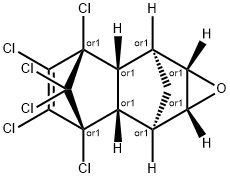Dieldrinsolution , 100μg/mlu=3% , 60-57-1
Synonym(s):
1,2,3,4,10,10-Hexachloro-1,4,4a,5,6,7,8,8a-octahydro-6,7-epoxy-1,4:5,8-dimethanonaphthalene
CAS NO.:60-57-1
Empirical Formula: C12H8Cl6O
Molecular Weight: 380.91
MDL number: MFCD00135591
EINECS: 200-484-5
PRODUCT Properties
| Melting point: | 143-144 °C(lit.) |
| Boiling point: | 496.11°C (rough estimate) |
| Density | 1.75 g/cm3 |
| vapor density | 13.2 (vs air) |
| vapor pressure | 30.7 and 58.5 at 20 and 25 °C, respectively (gas saturation-GC, Grayson and Fosbraey, 1982) |
| refractive index | 1.5550 (estimate) |
| Flash point: | 2 °C |
| storage temp. | APPROX 4°C |
| solubility | Soluble in ethanol and benzene (Weast, 1986) |
| Water Solubility | 195ug/L(25 ºC) |
| Merck | 3103 |
| BRN | 91396 |
| Henry's Law Constant | 27.6 at 5 °C, 63.2 at 15 °C, 82.9 at 20 °C, 97.7 at 25 °C, 217 at 35 °C:in 3% NaCl solution: 66.1
at 5 °C, 158 at 15 °C, 395 at 25 °C, 507 at 35 °C (gas stripping-GC, Cetin et al., 2006) |
| Exposure limits | NIOSH REL: TWA 0.25 mg/m3, IDLH 50 mg/m3; OSHA PEL: TWA 0.25 mg/m3; ACGIH TLV: TWA 0.25 mg/m3. |
| Stability: | Stable. Breakdown product of aldrin in the environment. Incompatible with acids, active metals and strong oxidizing agents. |
| IARC | 2A (Vol. 5, Sup 7, 117) 2019 |
| EPA Substance Registry System | Dieldrin (60-57-1) |
Description and Uses
Dieldrin is a colorless to light tan solid with amild chemical odor. The odor threshold in water is0.04 mg/L. Molecular weight=380.90; Boiling point =(decomposes); Freezing/Melting point=176.1℃; Vaporpressure=8 3 10 2 7 mmHg at 25℃. Hazard Identification(based on NFPA-704 M Rating System): Health 3,Flammability 0, Reactivity 0. Practically insoluble in water;solubility=0.02%.
Dieldrin was first used by cotton growers in the 1950s; it has
subsequently been used on other crops for the control of
vectorborne diseases and for mothproofing woolen goods.
Dieldrin, as well as other cyclodiene insecticides, is uniquely
suited for the control of termites. In 1974, the U.S. registration
of products containing aldrin and dieldrin was canceled.
As a result of worldwide concerns regarding the potential
human health and environmental impacts of dieldrin, its
manufacture ceased by the early 1990s.
Occupational exposures have occurred among all groups
that have been involved in the manufacture or handling of the
compound, and in the spraying of dieldrin suspensions and
emulsions. Overexposure, resulting in acute intoxication,
occurred primarily in the early days of dieldrin, aldrin,
and endrin manufacture and in spraying operations with
these compounds in Kenya, India, Iran, and other malariainfested
countries.
Safety
| Symbol(GHS) |    GHS06,GHS08,GHS09 |
| Signal word | Danger |
| Hazard statements | H300+H310-H351-H372-H410 |
| Precautionary statements | P202-P264-P273-P280-P301+P310-P302+P352+P310 |
| Hazard Codes | T+,N,Xn,F,T,Xi |
| Risk Statements | 25-27-40-48/25-50/53-36-20/21/22-11-39/23/24/25-23/24/25-67-65-38-51/53-52/53 |
| Safety Statements | 22-36/37-45-60-61-36-26-16-62-7 |
| RIDADR | UN 2811 6.1/PG 1 |
| OEB | C |
| OEL | TWA: 0.25 mg/m3 [skin] |
| WGK Germany | 3 |
| RTECS | IO1750000 |
| HazardClass | 6.1(a) |
| PackingGroup | II |
| HS Code | 29104000 |
| Hazardous Substances Data | 60-57-1(Hazardous Substances Data) |
| Toxicity | LD50 orally in rats: 46 mg/kg (Gaines) |
| IDLA | 50 mg/m3 |





